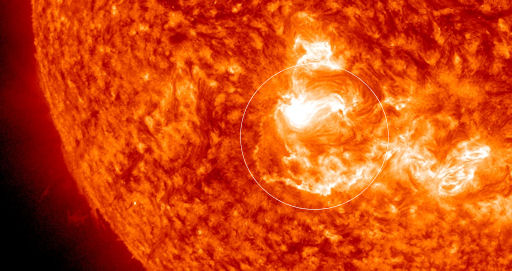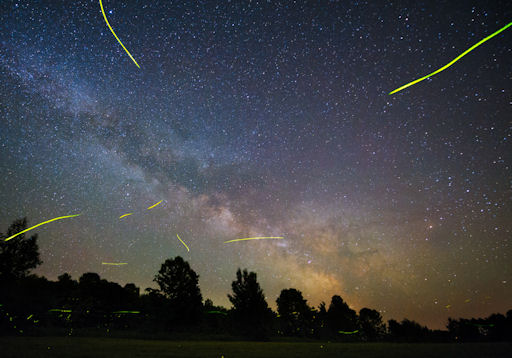CHANCE OF FLARES: NOAA forcasters estimate a 40% chance of M-class solar flares today as a phalanx of sunspots turns toward Earth. The most likely source of geoeffective eruptions is sunspot AR1504, which has grown into an active region almost 10 times wider than Earth. Solar flare alerts: text, voice.
As predicted, the sunspot has flared. Magnetic fields above AR1504 erupted on June 13th at 1319 UT, producing a long-duration M1-class solar flare. NASA's Solar Dynamics Observatory recorded the extreme UV glow of the blast:
The ongoing explosion is taking hours to unfold, which means it is very powerful despite its middling M1-peak. Long duration flares often hurl coronal mass ejections (CMEs) into space, and this one is probably no exception. Stay tuned for updates about a possible Earth-directed CME.
SUMMER LIGHTS: The signs of northern summer are beginning to appear in the skies over Canada. "For one thing, I can see the ISS several times each night as it flys through the solstice sunlight high above Earth," reports Guillaume Poulin of Cookshire, Québec, "Second, fireflies are very active. And finally I can see the Milky Way at 11 pm in shirt-sleeve weather." He documented the scene on June 12th:
Aware that a minor geomagnetic storm was underway, "I quickly framed my camera and started a 2 minute exposure in which I recorded the ISS, the Milky way, a swarm of fireflies, and the faint glow of the s

![]()
Solar wind
speed: 394.6 km/sec
density: 4.7 protons/cm3
explanation | more data
Updated: Today at 1536 UT
![]()
X-ray Solar Flares
6-hr max: M1 1319 UT Jun13
24-hr: M1 1319 UT Jun13
explanation | more data
Updated: Today at: 1500 UT
![]()
![]()
![]()
Daily Sun: 13 Jun 12
![]()
![]()
Sunspot 1504 poses a growing threat for Earth-directed M-class solar flares. Credit: SDO/HMI
![]()
![]()
![]()
Sunspot number: 132
What is the sunspot number?
Updated 12 Jun 2012
Spotless Days
Current Stretch: 0 days
2012 total: 0 days (0%)
2011 total: 2 days (<1%)
2010 total: 51 days (14%)
2009 total: 260 days (71%)
Since 2004: 821 days
Typical Solar Min: 486 days
Updated 12 Jun 2012
The Radio Sun
10.7 cm flux: 141 sfu
explanation | more data
Updated 12 Jun 2012
![]()
![]()
![]()
Current Auroral Oval:
![]()
Switch to: Europe, USA, New Zealand, Antarctica
Credit: NOAA/POES
![]()
![]()
![]()
Planetary K-index
Now: Kp= 1 quiet
24-hr max: Kp= 2 quiet
explanation | more data
![]()
Interplanetary Mag. Field
Btotal: 3.4 nT
Bz: 2.7 nT north
explanation | more data
Updated: Today at 1536 UT
![]()
![]()
![]()
Coronal Holes: 13 Jun 12
![]()
![]()
There are no large coronal holes on the Earthside of the sun. Credit: SDO/AIA.






